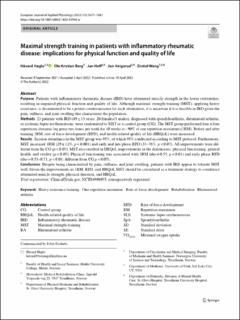| dc.description.abstract | Purpose: Patients with inflammatory rheumatic disease (IRD) have attenuated muscle strength in the lower extremities, resulting in impaired physical function and quality of life. Although maximal strength training (MST), applying heavy resistance, is documented to be a potent countermeasure for such attenuation, it is uncertain if it is feasible in IRD given the pain, stiffness, and joint swelling that characterize the population. Methods: 23 patients with IRD (49 ± 13 years; 20 females/3 males), diagnosed with spondyloarthritis, rheumatoid arthritis, or systemic lupus erythematosus, were randomized to MST or a control group (CG). The MST group performed four × four repetitions dynamic leg press two times per week for 10 weeks at ~ 90% of one repetition maximum (1RM). Before and after training 1RM, rate of force development (RFD), and health-related quality of life (HRQoL) were measured. Results: Session attendance in the MST group was 95%, of which 95% conducted according to MST protocol. Furthermore, MST increased 1RM (29 ± 12%, p = 0.001) and early and late phase RFD (33–76%, p < 0.05). All improvements were different from the CG (p < 0.05). MST also resulted in HRQoL improvements in the dimensions; physical functioning, general health, and vitality (p < 0.05). Physical functioning was associated with 1RM (rho = 0.55, p < 0.01) and early phase RFD (rho = 0.53–0.71, p < 0.01; different from CG p < 0.05). Conclusions: Despite being characterized by pain, stiffness, and joint swelling, patients with IRD appear to tolerate MST well. Given the improvements in 1RM, RFD, and HRQoL MST should be considered as a treatment strategy to counteract attenuated muscle strength, physical function, and HRQoL. | en_US |

